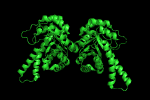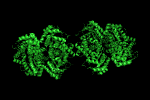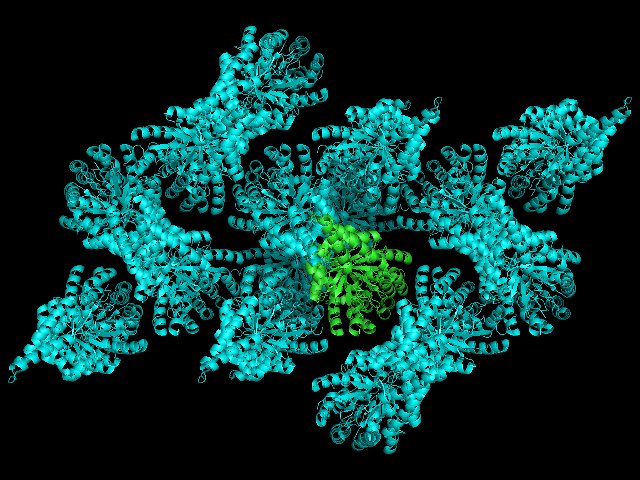Symexp: Difference between revisions
No edit summary |
No edit summary |
||
| Line 1: | Line 1: | ||
=== DESCRIPTION === | === DESCRIPTION === | ||
'''symexp''' is used to reconstruct neighboring asymmetric units from the crystallographic experiment that produced the given structure. This is assuming the use of a [http://www.rcsb.org/pdb/home/home.do PDB] file or equivalent that contains enough information to reproduce the lattice. | '''symexp''' is used to reconstruct neighboring asymmetric units from the crystallographic experiment that produced the given structure. This is assuming the use of a [http://www.rcsb.org/pdb/home/home.do PDB] file or equivalent that contains enough information to reproduce the lattice.<br> | ||
From the PyMOL developers: | |||
"'symexp' creates all symmetry related objects for the specified object | |||
that occurs within a cutoff about an atom selection. The new objects | |||
are labeled using the prefix provided along with their crystallographic | |||
symmetry operation and translation." | |||
=== USAGE === | === USAGE === | ||
In general:<br> | |||
symexp(prefix,object,selection,cutoff)<br> | |||
For one protein:<br> | |||
symexp name_for_new_objects,asymmetric_name,(asymmetric_name),distance<br> | symexp name_for_new_objects,asymmetric_name,(asymmetric_name),distance<br> | ||
* ''name_for_new_objects'' - PyMOL will generate a number of new objects corresponding to copies (rotated and translated) of the given asymmetric unit with the given name appended with a numerical counter | * ''name_for_new_objects'' (prefix) - PyMOL will generate a number of new objects corresponding to copies (rotated and translated) of the given asymmetric unit with the given name (prefix) appended with a numerical counter | ||
* ''asymmetric_name'' - this is the name of the loaded asymmetric unit that you wish to reproduce neighboring crystal partners for | * ''asymmetric_name'' (object) - this is the name of the loaded asymmetric unit that you wish to reproduce neighboring crystal partners for; the source of the symmetry operators | ||
* ''(asymmetric_name)'' - the same name, but with | * ''(asymmetric_name)'' (selection) - the same name, but with parentheses around it if you are reproducing a crystal from its asymmetric unit - the source of atom coordinates | ||
* ''distance'' - in Angstroms; reproduce any other unit that has any part of it falling withing ''distance'' Angstroms from the original | * ''distance'' (cutoff) - in Angstroms; reproduce any other unit that has any part of it falling withing ''distance'' Angstroms from the original asymmetric unit | ||
| Line 31: | Line 41: | ||
As you can see, we can begin to understand the crystal environment of our asymmetric unit. Increasing ''distance'' will reveal more of the crystal lattice, but will place in increasing demand on your computer's rendering ability.<br> | As you can see, we can begin to understand the crystal environment of our asymmetric unit. Increasing ''distance'' will reveal more of the crystal lattice, but will place in increasing demand on your computer's rendering ability.<br> | ||
NOTE: My PyMOL likes to crash if I ask it to ray trace or make a .png of anything that is too large. | NOTE: My PyMOL likes to crash if I ask it to ray trace or make a .png of anything that is too large. ''Too large'' varies, but (for instance) I was not able to ray trace the above picture using the default settings. Just making a .png image without the extra visual niceties rarely creates problems. | ||
Revision as of 14:42, 21 November 2008
DESCRIPTION
symexp is used to reconstruct neighboring asymmetric units from the crystallographic experiment that produced the given structure. This is assuming the use of a PDB file or equivalent that contains enough information to reproduce the lattice.
From the PyMOL developers:
"'symexp' creates all symmetry related objects for the specified object that occurs within a cutoff about an atom selection. The new objects are labeled using the prefix provided along with their crystallographic symmetry operation and translation."
USAGE
In general:
symexp(prefix,object,selection,cutoff)
For one protein:
symexp name_for_new_objects,asymmetric_name,(asymmetric_name),distance
- name_for_new_objects (prefix) - PyMOL will generate a number of new objects corresponding to copies (rotated and translated) of the given asymmetric unit with the given name (prefix) appended with a numerical counter
- asymmetric_name (object) - this is the name of the loaded asymmetric unit that you wish to reproduce neighboring crystal partners for; the source of the symmetry operators
- (asymmetric_name) (selection) - the same name, but with parentheses around it if you are reproducing a crystal from its asymmetric unit - the source of atom coordinates
- distance (cutoff) - in Angstroms; reproduce any other unit that has any part of it falling withing distance Angstroms from the original asymmetric unit
EXAMPLE
load any .pdb file into PyMOL (here we use 1GVF).
At the PyMOL command prompt type the following:
>> symexp sym,1GVF,(1GVF),1
produces three new objects. We now have four objects corresponding to two biologic units (the functional protein in a cell).
>> symexp sym,1GVF,(1GVF),5
If we color all of the sym* cyan we will produce the following:
As you can see, we can begin to understand the crystal environment of our asymmetric unit. Increasing distance will reveal more of the crystal lattice, but will place in increasing demand on your computer's rendering ability.
NOTE: My PyMOL likes to crash if I ask it to ray trace or make a .png of anything that is too large. Too large varies, but (for instance) I was not able to ray trace the above picture using the default settings. Just making a .png image without the extra visual niceties rarely creates problems.
--Baker1 13:41, 10 November 2008 (CST)


